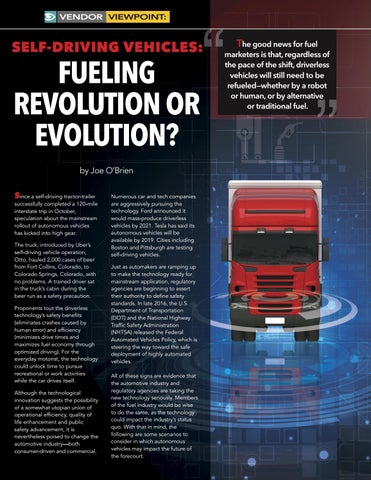VENDOR VIEWPOINT:
“
SELF-DRIVING VEHICLES:
FUELING REVOLUTION OR EVOLUTION? by Joe O’Brien Since a self-driving tractor-trailer successfully completed a 120-mile interstate trip in October, speculation about the mainstream rollout of autonomous vehicles has kicked into high gear. The truck, introduced by Uber’s self-driving vehicle operation, Otto, hauled 2,000 cases of beer from Fort Collins, Colorado, to Colorado Springs, Colorado, with no problems. A trained driver sat in the truck’s cabin during the beer run as a safety precaution. Proponents tout the driverless technology’s safety benefits (eliminates crashes caused by human error) and efficiency (minimizes drive times and maximizes fuel economy through optimized driving). For the everyday motorist, the technology could unlock time to pursue recreational or work activities while the car drives itself. Although the technological innovation suggests the possibility of a somewhat utopian union of operational efficiency, quality of life enhancement and public safety advancement, it is nevertheless poised to change the automotive industry—both consumer-driven and commercial.
Numerous car and tech companies are aggressively pursuing the technology. Ford announced it would mass-produce driverless vehicles by 2021. Tesla has said its autonomous vehicles will be available by 2019. Cities including Boston and Pittsburgh are testing self-driving vehicles. Just as automakers are ramping up to make the technology ready for mainstream application, regulatory agencies are beginning to assert their authority to define safety standards. In late 2016, the U.S. Department of Transportation (DOT) and the National Highway Traffic Safety Administration (NHTSA) released the Federal Automated Vehicles Policy, which is steering the way toward the safe deployment of highly automated vehicles. All of these signs are evidence that the automotive industry and regulatory agencies are taking the new technology seriously. Members of the fuel industry would be wise to do the same, as the technology could impact the industry’s status quo. With that in mind, the following are some scenarios to consider in which autonomous vehicles may impact the future of the forecourt.
”
The good news for fuel
marketers is that, regardless of the pace of the shift, driverless vehicles will still need to be refueled—whether by a robot or human, or by alternative or traditional fuel.
